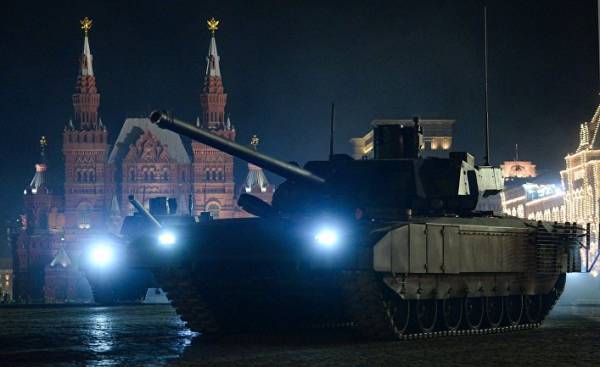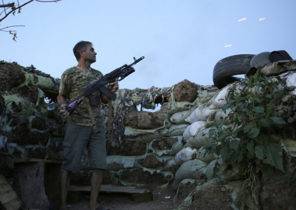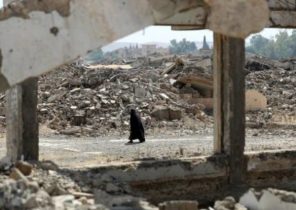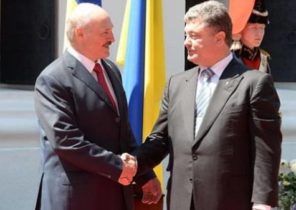
Yes, you heard correctly the last part is a heavy antitank missile system TOW sold worldwide — but radiant eyes American anti-love now looking towards greener pastures. Since the United States military in the mid 1990-ies have begun placing capable of swooping anti-tank missiles (ATGM) Javelin, they were actively giving away front-line units, alcoholic beverages to the party — almost every infantry unit has at its disposal several systems that it can call their own.
On the other hand, the new kids now do not allow for parties with Javelin ATGM. Ukraine showed at the door; Syrian rebels can never turn. That is why heavy anti-tank TOW missiles are in the hands of rebels from the free Syrian army, and they sent back one is not very mysterious benefactor. ATGM TOW has another important quality — the radius of his shooting 50% higher than the base model Javelin ATGM — although a new version soon change this ratio. But while you can sit back and enjoy the fresh air on top of the years with your missile ATGM TOW and revel in panoramic views while you are shooting video that you regularly post on YouTube.
So what is capable ATGM TOW (Tube-launched Optically-tracked Wire-guided) anti tank T-14 “Armata”, a mysterious Russian supertanker, which, according to rumors, is the secret embodiment of a robot-transformer, blessed with the ability to fly? Let’s compare the characteristics of the TOW anti-tank systems with the capabilities of the tank protection “Armata”, and see what sparks they strike together.
BGM-71 TOW (run out of the pipe induced by the optical channel and controlled by the wire) is a venerable American anti-tank missile of distant radius of action. She first entered service in 1970, and today it is available in many flavor variants: wireless, with a tandem warhead to attack from above and as the destroyer of bunkers. You can pick up a sample for every taste. Let’s put aside the older generation (sorry, ITOW) and focus our attention on two current models — for TOW-2A and TOW-2B.
As for ATGW TOW-2A, it uses a characteristic of this type of weapon control system through the wire. When the rocket is fired from the launch container with the help of the starting charge, located at the rear of the coil with a thin wire begins to spin, and it allows the launcher to send the commands during the flight to the target. In TOW ATGM system is used semi-automatic command line of sight (SACLOS) — this means that the operator controls the missile by holding the optical sighting mark on the target, and the system automatically adjusts it’s course. ATGW TOW-2A is capable of hitting targets at a distance of 3750 metres, but the rocket will require some time. The speed of its flight is about 180 meters per second, and this means that it will take about 22 seconds to hit a target at a maximum distance. During this time, warned members of the tank crew can take protective action — if you spot approaching missiles.
The control system on the wire has its advantages — it is not affected by various interferences. However need to statement remained in place and aimed the missile throughout its flight before hitting the target. Counter-measures, allowing to hinder the visibility of the target — for example, when using the old fashioned smoke can shoot down a missile with a sight.
When the missile TOW-2A hits the tank, is undermining high explosive anti-tank warheads (HEAT), which is also called the shaped charge or chemical core. Conventional projectiles rely on kinetic energy — for a combination of speed and mass to penetrate the armor. However, kinetic core need big guns, which is a huge impact. In addition, they lose their power when shooting at long distances. Instead of blasting blasting warheads creates the flow of small metallic particles moving at high speed; the larger shaped-charge projectiles able to penetrate thicker armor, but the speed of the projectile or missile has no effect on a penetrating impact. No need to have a long barrel or a heavy frame to absorb recoil — that’s why most missile warheads used with the system HEAT. Battle 6-inch shaped charge missiles TOW-2A is able to penetrate 900 mm rolled homogeneous armor.
However, since the 1980’s, designers began to produce tanks, equipped with protection against cumulative projectiles. In the production of Western tanks use Chobham composite armor. Soviet anti-tank missiles had the same effect on new tanks the Abrams and Challenger as paper balls at the Hippo. Russian designers, on the other hand, used a system of active protection — the briquettes explosives, which undermined at the approach of the rocket, and the result is cumulative warhead explodes before it would be in the vicinity of the tank. Active protection system is a little harder than composite armor, but it is cheaper, lighter in weight.
Active protection system capable of destroying all used ATGM TOW tricks. So missiles TOW-2A has a “tandem-charge”, that is, two warheads, one in the front in order to cause a detonation active protection, and the other in the back for penetration through the hole and the actual destruction of armor. In the most deadly types of anti-tank weapons such as RPG-29 and AT-14 Kornet and Javelin — used tandem charges.
However, tandem charges don’t completely foolproof, and so we have to consider now TOW 2B and TOW 2B Aero (this last range is 4.5 kilometers). Their founders rejected the wires and use wireless system to control hidden frequencies — but, nevertheless, they are vulnerable to various types of interference. However, the operator, in the literal sense of the word, is not tied to the rocket. Missile TOW-2B is able to make an unusual maneuver when approaching the target it can dramatically go up, and then powered two shaped charge, attacking the goal at the top. This provides it with a rocket of high efficiency, since the thickness of the armor of the tank top, as you know, small. There is also a wireless version of the missile TOW-2A.
And where you can see the TOW missiles? In the us army they are equipped with anti-tank platoons, and often these ATGM are mounted on a modified light vehicle (Humvee, Stryker, M113, LAV) and armored Bradley M2 and M3 and supplied naval forces attack helicopters AH-1 Corba. About 30 countries are armed with these anti-tank systems. And what can you say about the tanks T-14 “Armata” those who have become known that have survived after the rehearsal of the parade on Victory Day in 2015, when only one tank lost the ability to move! It is a pity that the infamous F-35 can’t boast the same result.
If you put aside the unsuccessful debut, the T-14 seems to have much more sophisticated security features compared with its predecessors. As the Victorian lady, the tank “armata” is a layered lower skirt to protect themselves from unwanted attention.
First of all, there is a System of active protection “Afghani” (Afganit Active Protection System), which is not only hard (hard kill), but soft (soft kill) means of destruction, driven four or five panels active phased array antenna (APAA). Protection of the system covers all structural elements of the tank, and also reports information about the flying projectile.
The system of “soft destruction” is fairly modest and is just trying to change the course located on the approach of the rocket. Four multispectral installing smoke grenades can provide jamming that are not only visually hide the tank, but also disguise its infrared footprint, thereby blocking the laser and radar guidance systems. Managed by the optical channel ATGM TOW it all does not matter, but if the operator cannot see the tank, then he may miss, especially if the armor is in motion. In theory, countermeasures work against missiles attacking from above — in particular, if they, unlike the ATGM TOW, not managed manually.
Then, we have a system of “hard-hitting” that can shoot down incoming missiles cocky, not willing to accept as answer “no”. The radar system “Afghani” automatically deploy the tower in the direction of the incoming missiles in order to be able to use the system active losses. Five guides of the containers on each side of the tower can direct the missile towards the approaching munition. The system of “Afghani” had not been tested in the other systems hard-hitting, including Trophy, has already proved its effectiveness in the fight against anti-tank missiles in real combat.
As for attacking from a height such ATGM like TOW-2B, then… it seems that the “Afghani” has no ability to shoot down incoming missiles from above.
If not activated system soft and hard protection, then “Armata” goes… that is, is the undermining of the system of dynamic protection “Relic”. Radar tank “Armata” so calculates the detonation of the charge of active protection to make it happen before the enemy missile or projectile reaches the target. Presumably, this undermining occurs sufficiently in advance in order to neutralize the warhead with tandem charge. But will it all go exactly? There is only one way to install! The Syrian rebels filmed the moment when the Syrian T-90 tank, apparently, was unharmed after the attack on him using TOW anti-tank systems due to the older system of active protection “Contact-5”.
But what if our unwavering missile TOW will be able to overcome all these protective borders? Will she be able to work my way up to the armored heart of the tank “Armata”?
If to talk about usual armor “Armata” is still considered to be slightly less protected than tanks M1A2 Abrams or the Leopard 2, and we assume that it weighs about 50 or 60 tons (For comparison: the M1 tank’s weight is 70 tons). According to Russian sources, cumulative shells will resist leaves ceramic armor equivalent to rolled homogeneous armor with a thickness of 1200 mm to 1400 mm. Apparently, this protection will be effective against missiles TOW-2A, are able to penetrate 900-millimetrical the armor, but it is impossible to say what will be the armored protection of the entire tower or the entire body (some experts believe that the tower will be much more vulnerable). While there is no way to verify how accurate these data are. In any case, ATGM TOW-2B still can handle the top armor.
And finally, we must consider an uninhabited turret of the tank “Armata”. The use of an uninhabited tower is connected with certain difficulties — including the risk of blinding the crew in the case when all sensors are disabled. However, there is a high probability that the crew can survive when hit by a projectile or missile into the tower. Even if the tower is down and the tank will need to send for repairs, maintaining the safe and sound crew is the most important for the modern professional armed forces. The tank can maximize its ability to withstand projectile impact in a tower case if it will be in the trenches, that is when you will only see its tower.
And what are the chances of ATGW TOW-2A? System soft protection of the tank “Armata” will work, if its radars are effective, and the crew will act quickly enough to have time to take a new position during the approach anti-tank missiles. But active protection system may have a good chance to destroy the rocket if it is, it is a defense, so good, as it is said. The system of dynamic protection “Relic” will likely further complicate the task for anti-tank missiles. But in any case, the ability of missiles TOW-2A to penetrate the frontal armor is very problematic. To summarize, we can say that may need a lot of missiles to one of them reached the goal.
It is not yet clear how many tanks of T-14 will be accepted into service — currently planned to produce only 100 copies. Their number will no doubt increase, but it is unclear how fast Russia will replace its older T-72БВ3 and T-90. Apparently, the tanks T-14 there is something to counter ATGM TOW, especially TOW-2A, however, the question is how well they will manifest themselves in a real fight, can’t give a definite answer even the American or Russian manufacturers. It is always a question of the balance of forces in direct confrontation — you can talk about anything, but their real meeting can give answers to all questions. Let’s hope these two never meet.
Sebastien Roblin received his master’s degree at Georgetown University; in the center of his research are issues related to conflict resolution. He also was a University instructor in the peace Corps in China.






